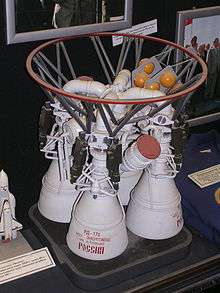RD-170
 RD-170 rocket engine model on exhibition in Saint Petersburg's Museum of Space and Missile Technology. | |
| Country of origin | Soviet Union/Russian Federation |
|---|---|
| First flight | 1985-04-13 |
| Manufacturer | NPO Energomash |
| Application | Main Engine |
| Associated L/V | Energia |
| Successor | RD-171M |
| Status | Retired |
| Liquid-fuel engine | |
| Propellant | LOX / RG-1 |
| Mixture ratio | 2.63 |
| Cycle | Oxidizer Rich Staged Combustion |
| Configuration | |
| Chamber | 4 |
| Nozzle ratio | 36.87 |
| Performance | |
| Thrust (vac.) | 7,904 kN (1,777,000 lbf) |
| Thrust (SL) | 7,257 kN (1,631,000 lbf) |
| Throttle range | 100% to 40% |
| Thrust-to-weight ratio | 75 |
| Chamber pressure | 24.52 MPa (3,556 psi) |
| Isp (vac.) | 337 s (3.30 km/s) |
| Isp (SL) | 309 s (3.03 km/s) |
| Burn time | 150 seconds |
| Dimensions | |
| Length | 4.0 m (160 in) |
| Diameter | 3.8 m (150 in) |
| Dry weight | 9,750 kg (21,500 lb) |
| Used in | |
| Energia | |
| References | |
| References | [1][2][3][4] |
The RD-170 (РД-170, Ракетный Двигатель-170, Rocket Engine-170) is the world's most powerful liquid-fuel rocket engine, designed and produced in the Soviet Union by NPO Energomash for use with the Energia launch vehicle. The engine burns the Russian equivalent of RP-1 fuel and LOX oxidizer in four combustion chambers, all supplied by one single-shaft, single-turbine turbopump rated at 170 MW in a staged combustion cycle.[3][5] By comparison, the Saturn V F-1 engines are the world's most powerful single-chamber combustion rocket engines.
Shared turbopump
Several Soviet and Russian rocket engines use the approach of clustering small combustion chambers around a single turbine and pump. During the early 1950s, many Soviet engine designers, including Valentin P. Glushko, faced problems of combustion instability while designing bigger thrust chambers. At that time they solved the problem by using a cluster of smaller thrust chambers.
Variants
RD-170
The RD-170 engine featured four combustion chambers and was developed for use on the Energia launch vehicle – both the engine and the launch vehicle were in production only for a short time.
RD-171

Building on the technology from the Energia launch vehicle the Zenit (rocket family) was developed, which uses a RD-170 variant, the RD-171. While the RD-170 had nozzles which swiveled on both axes, the RD-171 swivels on just one axis.[2] RD-171 was intended to be used on Zenit rocket, and one-axis swiveling allowed to avoid additional aerodynamic forces. Models called the RD-172 and RD-173 were proposed upgrades that would provide additional thrust, and the RD-173 proposal was finalized as the RD-171M upgrade in 2006.[2]
Dual-chamber derivative
The RD-180 uses only two combustion chambers instead of the four of the RD-170. The RD-180 used on the Atlas V, replaced the three engines used on early Atlas rockets with a single engine and achieved significant payload and performance gains. This engine had also been chosen to be the main propulsion system for the first stage of the now cancelled Russian Rus-M rocket.[6]
Single-chamber derivative
The RD-191 is a single-chamber version used in the Russian Angara rocket.[7] Variants of RD-191 include RD-151 in South Korean Naro-1 rocket,[8] RD-181 in American Orbital ATK Antares rocket, and the proposed RD-193 for the Soyuz-2-1v project.[9]
Proposed variants
On 28 July 2011 NPO Energomash summarised the results of the work on Rus-M rocket engine and considered the possibility of construction several new variants of RD-170 family engines.[10] According to the information, new and proposed variants will be marked as:
- RD-180M for manned Atlas V rocket (Not required, current RD-180 meets manned Atlas V requirements.)[11]
- RD-180V for Rus-M rocket.
- RD-175 with 9800 kN thrust for proposed Energia-K rocket.[12]
- RD-171MV for proposed Soyuz-5 (rocket).
In 2017, Director General of RKK Energia Vladimir Solntsev referred to a "simplified" and "cheaper" version of the RD-171 engine in connection with the Soyuz-5 (Sunkar) project.[13]
Specifications
- 4 combustion chambers, 4 nozzles
- 1 set of turbines and pumps - Turbine produces approximately 257,000 hp (192 MW); equivalent to the power output of 3 nuclear-powered icebreakers
- Ignition: Hypergolic start-up fuel capsule (Triethylaluminium)[14]
- Vacuum thrust of 7,887 kN (1,773,000 lbf)
- Vacuum Isp of 338 s (3.31 km/s)
- Sea Level Isp of 309 s (3.03 km/s)
- Weight: 9,750 kg (21,500 lb)
- Thrust to weight ratio: 82
See also
References
- ↑ "RD-171M". NPO Energomash. Retrieved 2018-02-22.
- 1 2 3 Ponomarenko, Alexander. "ЖРД РД-170 (11Д521) и РД-171 (11Д520)" [RD-170 (11D521) and RD-171 (11D520)] (in Russian). Retrieved 2015-10-08.
- 1 2 Wade, Mark. "RD-170". Encyclopedia Astronautica. Retrieved 2015-10-08.
- ↑ Krebs, Gunter Dick (2015-09-15). "Zenit family". Gunter's Space Page. Retrieved 2015-10-08.
- ↑ "South Korea to launch first space rocket on Aug. 19". Yonhap News Agency. 2009-08-25. Retrieved 2015-10-08.
- ↑ Coppinger, Rob (2009-08-11). "The Bear's stars shine brighter". Flight International. Retrieved 2009-08-22.
- ↑ "Successful Tests of Angara Stage 1 Engine". Khrunichev. 2007-12-12. Archived from the original on 2007-12-30.
- ↑ "First launch of KSLV-1 is conducted". 2009-08-25.
- ↑ Zak, Anatoly. "RD-193". russianspaceweb.com. Retrieved 2015-06-04.
- ↑ "Проведено заседание НТС" (in Russian). August 1, 2011. Archived from the original on September 30, 2011. Retrieved August 26, 2011.
- ↑ "Energomash 2011 catalog (Russian)". Roscosmos. Retrieved February 15, 2018.
- ↑ "Russia's Energomash: new rocket engines in development". VoiceofRussia.com. The Voice of Russia. 2012-02-22. Retrieved 2014-11-12.
- ↑ "Russia charts new path to super rocket". russianspaceweb.com. Retrieved February 15, 2018.
- ↑ http://lpre.de/energomash/RD-170/#flow_schematic_descr
